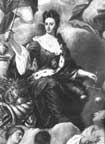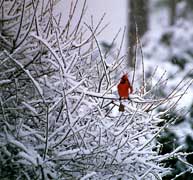 |
|||||||||||
|
Volume 13, Issue 5 ~ February 3 - February 9, 2005
|
|||||||||||
|
|
Musical heartbeat strong for 76-year-old physician To Dr. Richard Hochman, an internist at Anne Arundel Medical Center, Dixieland jazz is just what the doctor ordered. “It’s the most basic form of jazz,” says the piano-playing doctor of Dixieland, a style that originated in New Orleans but is played throughout the world. At 76, the native New Yorker continues to practice medicine and play piano with his Dynamic Dixieland Band. This week, he’ll help celebrate Mardi Gras, the Fat Tuesday before the long fast of Lent leading up to Easter, by bringing toe-tapping, upbeat Dixieland jazz to Rams Head Tavern. “A lot of physicians have musical talent,” Hochman said of the combinatiion that’s been his life’s work. “Both are very mathematical: music is based on harmonics and tones.” Medicine requires calculations and formulas, too. The silver-haired physician — attired in navy blazer, blue and yellow striped tie and khaki pants — looks every bit the serious doctor, but his piano-key scarf gives away his musical passion. The second-generation physician, first-generation musician is a family man, too. While talking in the cafeteria at Anne Arundel Medical Center, his grandchild paged him several times and his daughter stopped by. His son, Michael, one of his five children, plays saxophone in Hochman’s band, and, Hochman claims, can sing just like Louis Armstrong. “My father couldn’t whistle a tune,” Hochman confessed, his New York accent still surfacing. But music seemed to run in his veins. Hochman enrolled in New York’s Juilliard School when he was just five years old while still attending regular school. Studying the history of great musicians and classical piano was his springboard into a life filled with rhythms, chords and harmonies. Escaping from a strict piano teacher who brought a ruler to the back of his hands for poor form, Hochman fell under jazz’s spell while listening to jazz musician Jessie Gayle in the Catskill Mountains. “That’s when music was music,” Hochman said. Gayle taught him jazz piano, and Hochman began performing and leading jazz bands as a young teen. Hochman played his first gig at a prom as a pre-teen. “We thought we were hotshots,” Hochman said. He also played USO events and other local venues. As he grew older, Hochman learned to play everything from the clarinet to the glockenspiel, a xylophone-like instrument. In high school, he raised school spirit playing in the marching band. After medical school at New York University–Bellevue, the young doctor was drafted into the Navy during the Korean War. While in Tokyo with the Navy, Hochman was exploring streets lit with bright, Broadway-style neon signs and all the hustle and bustle of a big city when strains of jazz music wafted through the air. “We followed our ears to this little jazz club,” Hochman recalled. The language of music knew no boundaries. “I sat in for a full set, and it was like we’d been playing together forever.” The jazz band he plays with now, Dr. Hochman’s Dynamic Dixieland Band, is an eight-piece group that includes banjo, trumpet, clarinet and saxophone — in addition to his piano. With jazz and blues, Hochman explained, most of the music is improvised: “That’s both the beauty and mystery of this music,” he said. Hochman shares this love with his audiences. “I love to see people having a good time,” said Hochman, who pays attention to each group of listeners just as he does each patient. His performance gains energy from the exchange. “Sometimes there’s just this spontaneous outburst,” he says, “when the audience stands up and starts clapping.” During an intermission while the audience is milling about, he’ll often wander up to the piano and start playing some chords. Then the bass player will mosey over and add some strains, and the drummer will start setting some rhythms. Piece by piece, the music blossoms, and “it just builds up and builds up,” Hochman said. Leaving the Medical Center, Hochman spied a Steinway grand piano in the lobby and pulled up the bench to show what he meant. His agile fingers flew over the keys as jazzy Dixieland melodies rose through the three-story lobby. A grand finale on his impromptu lobby performance, including a swipe down the keyboard hitting every note, triggered applause from nurses listening from upstairs on the delivery floors. Hochman beamed and laughed at his unseen audience: “I just love it.” Celebrate Mardi Gras New Orleans-style with Dr. Hochman and his Dynamic Dixieland Band at their annual Mardi Gras jazz and blues show on Fat Tuesday, February 8, 8pm at Rams Head On Stage in Annapolis. $22.50: 410-268-4545. —Carrie Steele
Mark February 6, 2006, on your calendar, and next year you may meet Queen Anne Who is this Queen Anne whose name pursues us through Chesapeake Country? Annapolis is the city of Queen Anne. So, on a smaller scale, is the town of Queen Anne’s, a village at the intersection of Talbot, Caroline and another namesake, Queen Anne’s County. In front of that county courthouse in Centreville, a statue of Queen Anne was dedicated by a living namesake, Princess Anne, daughter of Queen Elizabeth II. Annapolis’ queen ruled England from 1702 until her death in 1714, initiating the golden age of 18th century and giving us Queen Anne architecture and furniture. She never traveled to the New World where her name flourished, for she was busy at home bringing England and Scotland into one island kingdom, Great Britain. She was also busy bearing children. She conceived at least 17 children with her husband, Prince George of Denmark. Only one, the Duke of Gloucester, survived infancy — only to die at the age of 11. The long-dead young duke is the namesake of Duke of Gloucester Street in downtown Annapolis and Williamsburg, Virginia. Back home in England, Anne, a devout protestant, passed her scepter to her German protestant cousins, the Hanovers, rather than have Great Britain returned to nearer, and English, Catholic relations. For centuries, place names were the heirless queen’s only recognition in her eponymous town. That changed when Annapolis Mayor Ellen Moyer discovered yet another link to Queen Anne. Both were married heads of government who carried on alone after losing their husbands. So it came to be that last year Moyer issued a proclamation establishing February 6, the birthday of the British sovereign for whom Annapolis is named, as Queen Anne’s Day. This year, a representative of the embassy of the United Kingdom of Great Britain and Northern Ireland will come to Annapolis to receive a tribute to Queen Anne. At a ceremony at Reynold’s Tavern, there will be a proclamation and Handel’s “Ode to the Birthday of Queen Anne,” recorded by Kings College Chorus of Cambridge, as well as a champagne toast provided by neighbors along Green Street. “This is a good time of year to look to our roots by remembering Queen Anne, celebrating her birthday this year as we will the birth of our city in 2008,” Moyer said. Beforehand, Queen Anne’s birthday is expected to be a public event, perhaps with a parade and an appearance by the queen whose name we all know. —David Fogle Fogle, professor emeritus of architecture of the University of Maryland, is Moyer’s special assistant for historic resources.
Plungers raise record $625,000 for Special Olympics For some, it’s never cold enough to stay away from the beach. Walt Wieczockowski stood alone, rosy and still on the frigid orange sands of Sandy Point State Park January 29. Wearing only shorts — but holding a toilet plunger on a 10-foot pole like a scepter — he showed no effects from the sub-freezing temperatures. “I had to shorten the handle this year, but people still think I’m with the Special Olympics,” said Wieczockowski explaining that he didn’t want his plunger to be mistaken for the cause’s signature torch. Wieczockowski is with Special Olympics Maryland one day each year, as for five years now he has joined Maryland State Police in their ritual, fund-raising Polar Bear Plunge. “Plus,” Wieczockowski said, “it helps ward off cabin fever.” This may not seem the behavior of a sane adult, but Wieczockowski represented relative sensibility in comparison to many of the 2,700 other polar plungers.
Others came for the cause and camaraderie and huddled, danced or merely shivered together in the midday chill as they awaited the official start of the plunge. Allie Broughton of Kent Island and Heather Dahoney of Waldorf were part of a group of 12 friends who sought safety in numbers. “We’re all first timers, and it sounded like a fun event for a good cause, but we can’t wait to warm up,” Broughton said. A one-time dip into the ice-covered waters of the Chesapeake is not beach enough for some all-weather bathers. One group takes the yearly plunge to the extreme. A couple dozen Super Plungers made the plunge every hour on the hour from 2pm January 28 through 2pm the following day for a total of 25 plunges. A diverse male and female group that includes law enforcement officers, a carpenter, a few salesmen, a seventh grader and a Special Olympics athlete, the Super Plungers sought to raise the stakes with their stunt and increase donations, passing around a bucket to the crowd as a prelude to each of their plunges. Their circadian efforts helped the State Police to bring in a record $625,000 for Special Olympics. Fears of frostbite and hypothermia are apparently unfounded. “This is the second plunge I’ve worked,” said Anne Arundel Paramedic Daniel Woolston, “and I’ve never seen an injury, even though the water temperature is 32 degrees.” Special Olympics Maryland says there has never been an injury in the history of the event.
Just as water temperature cannot drop below 32 degrees, some found comfort in the constancy of body temperature. “My body temperature is 98.5 degrees,” said Steve Myrick, Super Plunger and Special Olympian, as if that core certainty would keep him warm. Still law enforcement, paramedics and other safety workers stood by, and sponsors served hot food and drinks and set up warming tents. Two U.S. Coast Guard boats broke the ice to open the water for the swimmers, and a dive team from Anne Arundel County Fire Department and the Maryland Natural Resources Police linked hands and fanned out in the water near the beach, combing the shoreline to break up lingering patches of ice. The chilly crowd struggled to maintain the manic energy needed for such a swim as the guests of honor, Gov. Robert Ehrlich and Lt. Gov. Michael Steele, were delayed in traffic, an irony not lost on many in the bunch. “Now he knows how we feel at rush hour,” one man yelled toward the podium. Just before 2:30, Ehrlich and Steele arrived to give the crowd of plungers their final pep talk and to lead them into the near-frozen water. The New Jersey State Police “did 2,709,” Ehrlich said of our neighboring state’s recent plunge. “I’m confident we can beat that.” And with that they were off, a surprisingly orderly parade of more than 2,700 otherwise sane people going for a swim that would chill a penguin. Only one man admitted that he might have preferred to skip a cold day at the beach in January. “This is what happens to you,” said Steele, as he ran into the water, “when you have no job description.” —Ted Daly
Companion Gardening In Calvert County, Constellation Energy’s Calvert Cliffs Nuclear Plant is among 143 sites recognized internationally by the Wildlife Habitat Council for its conservation planning. Wild turkeys especially like the heavily guarded 2,100-acre Bayfront site, rich with mature hardwoods, pine forests and grassy fields ... |
||||||||||






 How Snow Birds Stand the Chill
How Snow Birds Stand the Chill lant Professor
lant Professor